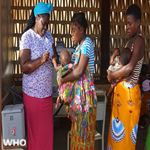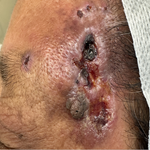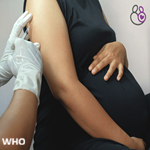How antiretroviral therapy (ART) programmes in Africa can maintain treatment for people living with HIV (PLHIV) during COVID-19 pandemic
Cavin Epie Bekolo
Corresponding author: Cavin Epie Bekolo, The University of Dschang Taskforce for the Elimination of COVID-19 (UNITED#COVID-19), Dschang, Cameroon 
Received: 09 Jun 2020 - Accepted: 19 Jun 2020 - Published: 21 Jun 2020
Domain: Health system development,Global health
Keywords: HIV, ART, retention, differentiated care, COVID-19, Africa
This article is published as part of the supplement PAMJ Special issue on COVID - 19 in Africa, commissioned by The Pan African Medical Journal.
©Cavin Epie Bekolo et al. Pan African Medical Journal (ISSN: 1937-8688). This is an Open Access article distributed under the terms of the Creative Commons Attribution International 4.0 License (https://creativecommons.org/licenses/by/4.0/), which permits unrestricted use, distribution, and reproduction in any medium, provided the original work is properly cited.
Cite this article: Cavin Epie Bekolo et al. How antiretroviral therapy (ART) programmes in Africa can maintain treatment for people living with HIV (PLHIV) during COVID-19 pandemic. Pan African Medical Journal. 2020;35(2):85. [doi: 10.11604/pamj.supp.2020.35.2.24180]
Available online at: https://www.panafrican-med-journal.com//content/series/35/2/85/full
Letter to the editors 
How antiretroviral therapy (ART) programmes in Africa can maintain treatment for people living with HIV (PLHIV) during COVID-19 pandemic
How antiretroviral therapy (ART) programmes in Africa can maintain treatment for people living with HIV (PLHIV) during COVID-19 pandemic
Cavin Epie Bekolo1,2,3,&
&Corresponding author
Remarkable progress has been achieved in the past decade with record numbers accessing antiretroviral therapy (ART) in developing countries at the epicentre of the HIV epidemic in sub-Saharan Africa (SSA). However, the momentum of scaling up access to ART and maintaining the rising number of PLHIV on treatment is facing a significant threat from the rapid spread of the coronavirus pandemic to and within these countries. We learnt from the Ebola outbreak in 2014-2015 that a significant decrease in health service utilisation for HIV care was reported with rates of defaulting in ART care reaching 42% at the peak of the epidemic in Guinea [1-3]. The already fragile health systems in SSA are yet to be further stretched given fewer cases of COVID-19 reported so far but the anxiety surrounding the virus coupled with restrictive measures to contained it suggests that PLHIV and healthcare workers are “staying at home” for fear of contracting the virus in the healthcare setting. The likely consequence is that PLHIV may die mostly from interruptions in their ART care than from COVID-19. In responding to COVID-19 countries in SSA must think about sustaining essential services for prevailing conditions including HIV-AIDS which is a more deadly disease than COVID-19 in the continent. There is no one way of doing this because of context-specific challenges.
Some of the ways by which we can keep patients on ART while they respect the “stay-at-home” messages are: multi-month prescriptions (MMP) and Multi-Month Dispensing (MMD) for at least 3 months and up to 6 months especially for stable patients [4,5]. This allows for ample and interrupted medication supply for patients and reduction of workload for healthcare workers. This may however require a strong supply chain management system for antiretroviral medicines to avoid stockouts that are unfortunately frequent; appointment spacing for clinical visits to at least 3 months and up to 6 months for stable patients [6]. Less frequent contacts between HCW and patients will reduce potential exposure to SARS-CoV-2 for both and will ease pressure on the already stretched health system; community ART distribution points managed by PLHIV themselves who form a network and are trained to provide ART refills, adherence support and follow-up of basic support and follow-up health assessments as in Kinshasa in the Democratic Republic of the Congo [5].
Community ART groups (CAGs): they are self-formed groups of about six stable patients on ART from a community in the same geographic location as in Tete in Mozambique. Group members take turns every 3 - 6 months collecting antiretroviral medicines at the clinic for all the members and then redistribute medication to other group members. Members also provide adherence support and monitor treatment outcomes [5]; home delivery and dispensation of medicines by community health workers who equally provide psychological and social support for PLHIV as practised in Cameroon; virtual support for PLHIV who need clinical care via telephone, messaging including WhatsApp, telemedicine, online portals and other available digital tools to minimise the need to access an overburdened health system during time of response and risk increased exposure to SARS-CoV-2 at health facilities; health facilities should develop specific standard operating procedures with clear patient routes and specific infection, prevention and control (IPC) measures to ensure safety for personnel and patients including PLHIV who need clinical consultations.
We hope these models of care delivery that have demonstrated their potential to reduce burdens for patients and the health system, to increased retention in care and to lower service provider costs in normal and emergency situations, may be used in any combination according to context to ensure uninterrupted ART care in SSA as the pandemic unfolds.
The author declares no competing interests.
CEB did the conception, literature search, synthesis and write up. The author has read and agreed to the final manuscript.
The team of Research Reaching Rural and Remote Residents (5R), the District Medical Office, Nkongsamba, Cameroon.
- Leuenberger D, Hebelamou J, Strahm S, De Rekeneire N, Balestre E, Wandeler G et al. Impact of the Ebola epidemic on general and HIV care in Macenta, Forest Guinea, 2014. AIDS. 2015;29(14):1883-7. PubMed | Google Scholar
- Ndawinz JD, Cisse M, Diallo MS, Sidibe CT, D'Ortenzio E. Prevention of HIV spread during the Ebola outbreak in Guinea. Lancet. 2015;385(9976):1393. PubMed | Google Scholar
- Brolin Ribacke KJ, Saulnier DD, Eriksson A, von Schreeb J. Effects of the West Africa Ebola virus disease on health-care utilization - a systematic review. Front Public Health. 2016;4:222. PubMed | Google Scholar
- World Health Organization. COVID-19: Operational guidance for maintaining essential health services during an outbreak. Interim guidance. 25 March, 2020. Google Scholar
- UNAIDS and Médecins Sans Frontières. Community-based antiretroviral therapy delivery. 2015.
- Bekolo CE, Diallo A, Philips M, Yuma JD, Di Stefano L, Drèze S et al. Six-monthly appointment spacing for clinical visits as a model for retention in HIV Care in Conakry-Guinea: a cohort study. BMC Infect Dis. 2017 Dec 13;17(1):766. PubMed | Google Scholar
Search
This article authors
On Pubmed
On Google Scholar
Citation [Download]
Navigate this article
Similar articles in
Key words
This supplement
- Clinical presentation, case management and outcomes for the first 32 COVID-19 patients in Nigeria (Accessed 18958 times)
- COVID-19 and the Nigerian child: the time to act is now (Accessed 17894 times)
- Profil clinique, biologique et radiologique des patients Algériens hospitalisés pour COVID-19: données préliminaires (Accessed 10355 times)
- The COVID-19 pandemic and social distancing in Nigeria: ignorance or defiance (Accessed 6430 times)
- Knowledge, risk perception and preparedness towards coronavirus disease-2019 (COVID-19) outbreak among Ghanaians: a quick online cross-sectional survey (Accessed 6234 times)
- Continuity of health service delivery during the COVID-19 pandemic: the role of digital health technologies in Uganda (Accessed 4205 times)
- Knowledge, risk perception and preparedness towards coronavirus disease-2019 (COVID-19) outbreak among Ghanaians: a quick online cross-sectional survey (Downloaded 868 times)
- Clinical presentation, case management and outcomes for the first 32 COVID-19 patients in Nigeria (Downloaded 611 times)
- The COVID-19 pandemic and social distancing in Nigeria: ignorance or defiance (Downloaded 601 times)
- Profil clinique, biologique et radiologique des patients Algériens hospitalisés pour COVID-19: données préliminaires (Downloaded 473 times)
- Continuity of health service delivery during the COVID-19 pandemic: the role of digital health technologies in Uganda (Downloaded 456 times)
- COVID-19 and the Nigerian child: the time to act is now (Downloaded 350 times)









